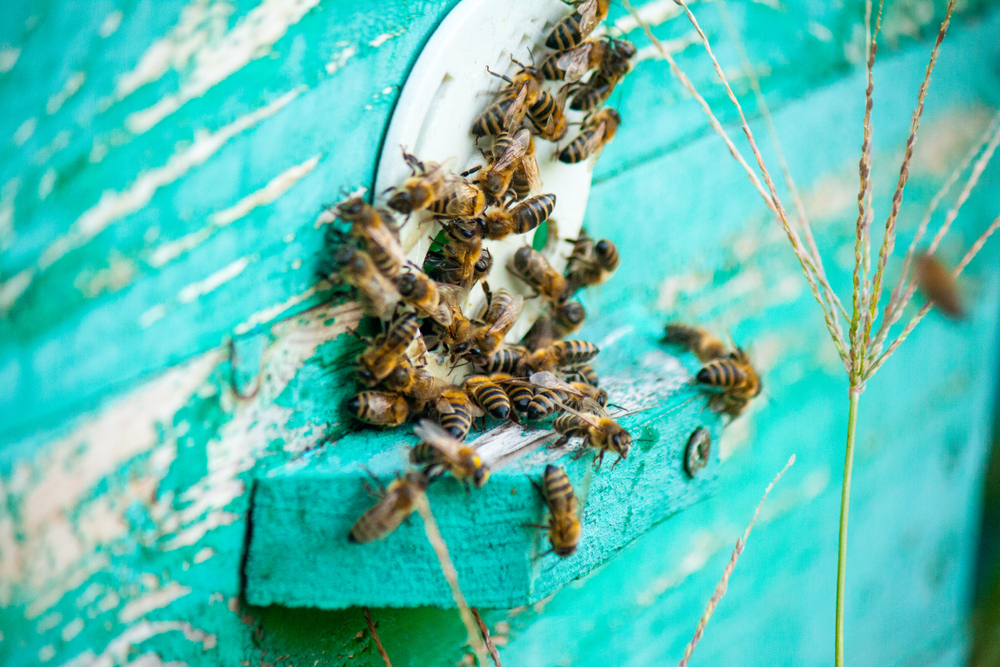It’s that time of the year when lots of Americans are dusting off their hiking and camping gear. Many folks are allowing themselves to get lost in nature and enjoy the scenery Mother Nature has prepared for them.
However, certain adversaries in the great outdoors do not like to be disturbed, and their strength in numbers makes them a formidable adversary for the unwary explorer.
The adversaries in question are bees and dealing with them should not be a dangerous activity as long as you know and respect a few rules.
What makes bees attack?
A key fact to remember is that bees, in general, do not intend to seek and attack you, and they have other businesses to take care of. Even so, some unexpected events make them restless and aggressive, and a change in bee-havior (pun intended) usually occurs when the queen goes missing.
Another event that makes bees hostile is the lack of food, and when there’s not enough nectar on the surrounding plants, they will seek out neighboring hives to attack and loot. Everything or everyone that is caught in the battle between the two factions becomes collateral damage.
The weather is another factor that can influence how bees act. Rainy weather followed by high heat and an increase in humidity can increase bee aggression, and they will attack anyone or anything crossing their path.
And last but not least, the battleground between bee factions can create an inviting scene for other stingy insects. The smell of honey and dead bees is irresistible to wasps, yellow jackets, and hornets as they rush in to collect the dead bees and honey. Those nearby will find themselves in a dangerous situation, unaware of the unfolding feeding frenzy.
Getting stung
Bee stings have various effects on people, and the severity and symptoms can vary greatly from one person to another. The severity of bee stings grows exponentially with the number of stings someone receives and the individual’s tolerance to bee venom.
Some people are allergic to bee venom and being stung even by a few bees can turn into a life-threatening situation. Spread across the body, the stings deliver the venom that creates an allergic reaction with symptoms such as the rapid swelling of the lips, eyes, tongue, and throat. Symptoms may also include hives, itching, dizziness, rashes, breathing difficulties, and the loss of consciousness.
Fortunately, we can all minimize the risk of being attacked by a dangerous swarm with a little common sense and know-how when enjoying our trek through the wilderness.
Here are some practical tips to avoid a bee attack:
Don’t stand out
Some people attract unwanted attention when they wear perfume or cologne. Wearing a sweet-smelling fragrance in the outdoors will make you look like a giant flower since bees and wasps can detect strong scents with ease.
Also, when doing your daily trek, you should avoid wearing brightly colored prints, and you should pick only neutral colors. Kaki, white and beige are the colors to go with since they will decrease your chances of being inspected by curious bees.
Pay attention to what you eat
All the sweet and sugary foods you bring in the wilderness become a magnet for hungry bees, wasp, and other sting-armed insects. An opened can of soda attracts one or more bees, and when they contact the container, they will signal to other bees that food is nearby.
To avoid having unwanted guests, always cover your cans and food containers. If you like to bring some fruit snacks along, make sure you finish the snack and don’t leave the fruit skin lying around. If you carry a garbage container, make sure it is tightly closed when you’re not using it.
Dress for the unexpected
A few years back, I was talking with a park ranger about bee attacks, and he told me that one thing people should learn when venturing outdoors is to avoid wearing loose-fitting clothing.
Some folks wear short pants while the ladies go with dresses for that perfect Instagram shot. However, loose-fitting clothing allows bees (and other insects) to find their way easier to your soft skin. Once you feel their presence, you instinctively scratch the area, and that’s all it takes to provoke a nasty sting or bite.
As for footwear, I’ve noticed there’s an increasing trend in walking around barefoot as a way to reconnect with nature. I say to each its own, but if a bee is disturbed or trampled underfoot, it will easily find a soft target to sting. I advise you to wear appropriate footwear when exploring the great outdoors as it will save you a lot of headaches.
If attacked, Run!
You may encounter one or two bees during your hike or when you take that much-needed break; however, they will just fly around you and won’t attack if they aren’t provoked. If you stay still, they will soon realize you are not a giant flower, and they will leave you alone. However, when a few dozens of bees are heading your way, you better run!
Don’t wave your hands trying to scare them away, as you will only provoke them to attack. Save your energy and run to the nearest enclosed shelter as soon as possible. It is advised to cover your face with a shirt or towel, but you should do so while running since stopping can cost you greatly.
Find proper shelter
I’ve mentioned the need to head to a shelter when dealing with a swarm, but not every shelter is suited to protect you from an attack. You need to find a sealable shelter like a building or a vehicle where bees can’t enter. Even a zipped tent or a nearby park restroom will work to protect you against a raging swarm.
If the above-mentioned options are not available, you can use a blanket, a sleeping bag, and even a heavy comforter to improvise a barrier between you and the venomous stingers. Pay attention to not leave any openings exposed and wait patiently under the cover until you hear the bees flying away before getting up and running to safety.
There is a myth about protecting yourself from bees by jumping into a water hole or a swimming pool. Don’t do this since this is mostly fiction, and bees will just way above the surface and wait for you to cum up for air.
If you get stung, you should remove the stingers
The inevitable happened, and somehow you got stung, now what?
As soon as you are in a shelter or safely away from the swarm, you need to remove the stingers if honeybees attacked you. Honeybees leave the stinger in the skin, and they die in the process of stinging you. If the stinger remains attached to your skin, the venom will continue to enter your bloodstream.
When removing the stingers, you should avoid using your fingers or a pair of tweezers because you will only squeeze the venom sack, and you will inject more venom into your bloodstream. Instead, you can scrape the stinger using the blade of a knife (preferably a dull blade) or even a credit card.
Seek out medical help
Establishing how severe a sting depends on many factors, but a general rule states that a non-allergic person can survive (or tolerate) ten stings per pound of body weight. This means that the average human can tolerate almost one thousand stings. However, if the person is allergic, even a single sting can cause crippling symptoms.
If you know that an individual in your party is allergic to bee venom, you should always carry an EpiPen in case the unexpected happens. This is a lifesaver in case an acute allergic reaction occurs (anaphylaxis), and it can be easily administrated before professional medical assistance becomes available.
Seek medical assistance immediately if a person shows signs of an allergic reaction. Some people discover they are allergic to bee venom by accident, so having the knowledge to provide first-aid becomes a must when you find yourself in the wilderness.
First-aid basics
Most folks can attest that a bee sting is an unpleasant and painful experience. These small creatures can pack a punch, and to ease the pain they cause, there are certain remedies you can employ. Here are some suggestions:
Hydrocortisone cream – This a drugstore staple that can provide relief if applied to the affected area, and it works fast.
Calamine lotion – Another easy-to-find drugstore staple, this lotion will ease the burning sensation caused by bee stings. Keep in mind that the effect of one application lasts for about an hour, and you will have to apply another coat for sustained relief.
Benzocaine sticks and antihistamines – Both will relieve the pain caused by bee stings, but their effect can last anywhere from 15 minutes up to an hour. These are good temporary remedies until a better solution is found.
Ice – If nothing else is available, ice can be successfully used to calm a bee sting. Wrap some ice in a cloth and hold it on the affected area for about 20 minutes. The cold will slow down the flow of bee venom into the bloodstream as the blood vessels start to constrict. Ice will also numb the pain and calm the itching sensation.
Honey – Ironically, the prized possession of bees, the one thing that can lead to stings and wars in the bee world, can also help alleviate pain. Apply on the affected area, and it will provide a pain-relieving effect.
A last word
You can get stung by one or more bees not only in the wilderness but also in your very own backyard. It is recommended to perform regular inspections on your property during early spring and until the end of summer (when bees are most active) to discover if you have unexpected neighbors or visitors.
Bees will nest in sheds, tall and thick-leaved trees, roof overhangs, and pretty much everywhere on your property. By inspecting your land, you can limit the size of growing bees’ nests and ultimately avoid the hassle of dealing with bee stings. Always take precautions and wear protective attire when dealing with even seemingly small nests.
>>> GET THE BOOK TO DISCOVER MORE <<<

























































































Running is fine if you can see where you are going. Many injuries and even deaths are due to the victim running into trees, cacti, or even off of a cliff. Bees go for the face as they cue in on CO2. The best thing you can do is carry an insect net for your head in all of your backpacks, hydration packs, or just your pocket. Then, if an attack happens, you can put the protection over your head, limit stings to the face to only the number of bees that got in during the donning of the net and you can then see where you are running.
Just stay calm you morons! If they sting you, for sure they will try to take out their stinger since they die without it. I know it hurts especially if you are the sensible type but just don’t be a p***y if you’re out in the wilderness!!!